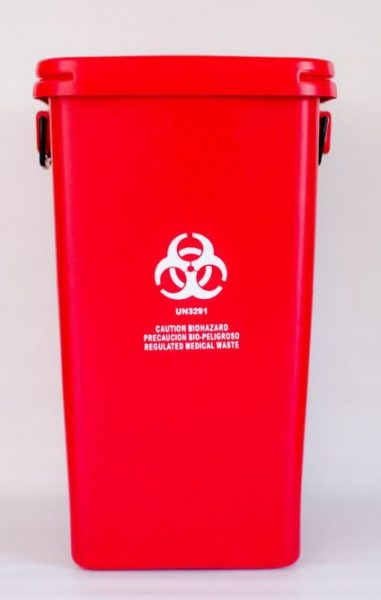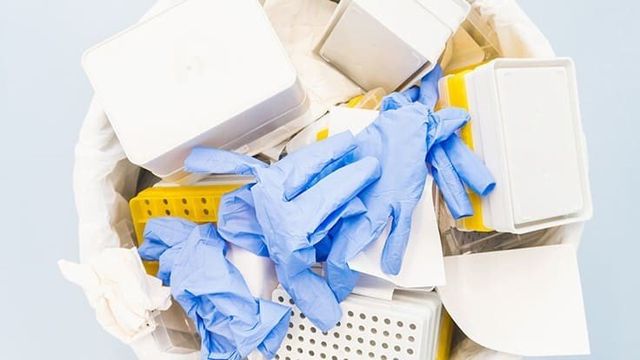Defending Well-Being: Unveiling the Significance of Specialist Medical Waste Removal
Defending Well-Being: Unveiling the Significance of Specialist Medical Waste Removal
Blog Article
Stay Ahead of Laws: Professional Suggestions on Medical Waste Disposal
In a world where the medical care sector is regularly advancing, it is important for medical centers to stay in advance of guidelines when it comes to the appropriate disposal of medical waste. From recognizing the different categories of clinical waste to executing the right collection and partition methods, this conversation will provide workable ideas and valuable understandings to help centers stay in advance of regulations in the ever-changing landscape of clinical waste disposal.
Understanding Clinical Waste Categories
Recognizing medical waste classifications is important for correct disposal and administration in health care centers. Clinical waste describes any waste created by healthcare tasks that may present a threat to public wellness or the environment. It is vital to categorize medical waste properly to ensure its risk-free handling, treatment, disposal, and transport.
There are numerous categories of medical waste that health care centers require to be aware of. The most typical groups consist of infectious waste, pathological waste, sharps waste, pharmaceutical waste, and chemical waste. Each classification has certain standards and regulations for its proper administration and disposal.
Transmittable waste consists of products contaminated with blood or other bodily fluids, such as gloves, gowns, and lab societies. Pathological waste describes human cells, body organs, or body components that call for special delivery and disposal. Sharps waste consists of used needles, syringes, and other sharp objects that can cause injury and transmit infections. Pharmaceutical waste comprises expired, unused, or contaminated drugs that need careful handling and disposal. Chemical waste consists of solvents, anti-bacterials, and various other chemical compounds utilized in health care facilities.
Staying Up-To-Date With Regulatory Modifications
Staying existing with governing modifications is vital for medical care centers to make sure compliance and proper monitoring of clinical garbage disposal. medical waste removal service. With regulations constantly advancing, it is necessary for health care facilities to remain updated to avoid fines, penalties, and potential harm to the setting and public health and wellness
To stay in advance of regulatory adjustments, health care facilities need to establish a system for monitoring and monitoring updates. This can be done by subscribing to governing e-newsletters, attending meetings and workshops, and proactively taking part in industry organizations. Additionally, centers should mark a personnel or team liable for staying notified and disseminating info to relevant stakeholders.
Routine interaction with regulatory firms is also crucial. Healthcare facilities need to establish connections with neighborhood, state, and federal firms to ensure they are conscious of any kind of changes in guidelines that might impact their waste monitoring practices. This can be done through normal conferences, participation in public comment durations, and aggressive engagement with governing firms.
Moreover, health care centers must consider partnering with waste monitoring business that specialize in clinical waste disposal (medical waste disposal services with WasteX). These firms are often skilled in the most up to date regulations and can offer support and assistance to make certain compliance
Implementing Appropriate Collection and Segregation Techniques
To properly take care of clinical garbage disposal, medical care centers have to develop correct collection and partition approaches according to governing standards. Applying these approaches makes certain the secure handling and disposal of possibly unsafe products, secures the atmosphere, and lessens the danger of injuries and infections to health care workers and the public.
Proper collection and partition approaches include using designated containers and labeling systems. Medical care centers must supply clearly labeled containers for various sorts of medical waste, such as sharps, infectious waste, pharmaceutical waste, and non-hazardous waste. These containers should be color-coded and plainly marked to avoid complication and advertise simple identification.
In addition, health care facilities need to educate their personnel on the correct treatments for gathering and segregating clinical waste. This includes educating them on the various types of waste, the appropriate containers to make use of, and the significance of following guidelines and guidelines. Normal training sessions and refresher programs ought to be carried out to make sure that team member remain up-to-date on ideal methods.
Additionally, medical care facilities should develop a system for regular collection and disposal of clinical waste. This might include partnering with qualified waste administration firms that focus on clinical waste disposal. These firms will make sure that the collected waste is delivered and gotten rid of in conformity with regulatory demands.
Choosing the Right Disposal Techniques

Incineration is just one of one of the most usual and reliable methods for throwing away particular kinds of clinical waste, such as pathological waste and sharps. It entails the regulated burning of waste at heats, lowering it to ash. Nonetheless, incineration can launch harmful pollutants right into the air and add to air contamination.

Chemical therapy entails the use of chemicals to disinfect and reduce the effects of the waste. Microwave therapy makes use of microwave power to warmth and decontaminate the waste.
Ensuring Compliance Through Documentation and Training
After carefully thinking about the suitable disposal techniques for medical waste, health care facilities should guarantee compliance with regulations and minimize environmental influence by applying reliable documents and training treatments. This step is essential in keeping a secure and lasting environment for both medical care workers medical waste disposal services with WasteX and the general public.

Training is equally crucial in ensuring compliance with guidelines. Medical care workers who manage clinical waste should get proper training on waste partition, taking care of, and disposal treatments. This training needs to cover topics such as the appropriate usage of individual safety equipment, identification of various kinds of waste, and the proper disposal approaches for each waste group. By giving detailed training, health care centers can encourage their personnel to make informed choices and find out here decrease the danger of improper waste disposal.
Verdict
To conclude, remaining in advance of guidelines in medical waste disposal is vital for medical care centers. medical waste removal service. Understanding the different groups of clinical waste, staying updated with governing adjustments, carrying out appropriate collection and segregation approaches, selecting the suitable disposal approaches, and making certain conformity through documentation and training are all crucial actions. By following these guidelines, medical care companies can efficiently manage and get rid of of medical waste in a secure and liable way
From understanding the various classifications of clinical waste to implementing the appropriate collection and partition methods, this conversation will give actionable ideas and important understandings to assist centers stay in advance of regulations in the ever-changing landscape of clinical waste disposal. - medical waste disposal services with WasteX
The most usual categories include contagious waste, pathological waste, sharps waste, pharmaceutical waste, and chemical waste. Medical care centers need to provide plainly identified containers for various kinds of clinical waste, such as sharps, transmittable waste, pharmaceutical waste, and non-hazardous waste. Medical care facilities ought to establish a detailed system to videotape and track all facets of clinical waste disposal, consisting of kinds of waste created, amounts, and disposal approaches utilized. Health care employees that manage medical waste must get appropriate training on waste segregation, dealing the original source with, and disposal procedures.
Report this page